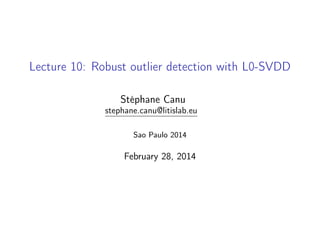
Lecture10 outilier l0_svdd
- 1. Lecture 10: Robust outlier detection with L0-SVDD Stéphane Canu stephane.canu@litislab.eu Sao Paulo 2014 February 28, 2014
- 2. Roadmap 1 Robust outlier detection with L0-SVDD L0 SVDD 4 iterations of Adaptive L0 SVDD
- 3. Recall SVDD min R,c,ξ R + C n i=1 ξi with xi − c 2 ≤ R + ξi , i = 1, . . . , n and ξi ≥ 0, i = 1, . . . , n (1) Stéphane Canu (INSA Rouen - LITIS) February 28, 2014 3 / 11
- 4. SVDD + outlier C =1/16 C =1/8 C =1/4 C = 1/2 ( ) Figure: Example of SVDD solutions with different C values, m = 0 (red) and m = 5 (magenta). The circled data points represent support vectors for both m. Stéphane Canu (INSA Rouen - LITIS) February 28, 2014 4 / 11
- 5. The L0 norm ξ 0 ≤ t min c∈IRp ,R∈IR,ξ∈IRn R + C ξ 0 with xi − c 2 ≤ R+ξi ξi ≥ 0 i = 1, n Stéphane Canu (INSA Rouen - LITIS) February 28, 2014 5 / 11
- 6. L0 relaxations p norm exponenetial piecewise linear log min c∈IRp ,R∈IR,ξ∈IRn R + C n i=1 log(γ + ξi ) with xi − c 2 ≤ R+ξi ξi ≥ 0 i = 1, n . Stéphane Canu (INSA Rouen - LITIS) February 28, 2014 6 / 11
- 7. DC programing log(γ + t) = f (t) − g(t) with f (t) = t and g(t) = t − log(γ + t), both functions f and g being convex. The DC framework consists in minimizing iteratively (R plus a sum of) the following convex term: f (ξ) − g (ξ)ξ = ξ − 1 − 1 γ + ξold ξ = ξ γ + ξold , where ξold i denotes the solution at the previous iteration. Stéphane Canu (INSA Rouen - LITIS) February 28, 2014 7 / 11
- 8. The DC idea applied to our L0 SVDD approximation consists in building a sequence of solutions of the following adaptive SVDD: min c∈IRp ,R∈IR,ξ∈IRn R + C n i=1 wi ξi with xi − c 2 ≤ R+ξi ξi ≥ 0 i = 1, n with wi = 1 γ + ξold i . Stéphane Canu (INSA Rouen - LITIS) February 28, 2014 8 / 11
- 9. Stationary conditions of the KKT give: c = n i=1 αi xi and n i=1 αi = 1 where the αi are the Lagrange multipliers associated with the inequality constraints xi − c 2 ≤ R+ξi . The dual of this problem is min α∈IRn α XX α − α diag(XX ) with n i=1 αi = 1 0 ≤ αi ≤ Cwi i = 1, n (2) Stéphane Canu (INSA Rouen - LITIS) February 28, 2014 9 / 11
- 10. Algorithm 1 L0 SVDD for the linear kernel Data: X, y, C , γ Result: R , c, ξ , α wi = 1; i = 1, n while not converged do (α, λ) ← solve_QP(X, C, w) % solve problem (2) c ← X α R ← λ + c c ξi ← max(0, xi − c 2 − R) i = 1, n wi ← 1/(γ + ξi ) i = 1, n end Stéphane Canu (INSA Rouen - LITIS) February 28, 2014 10 / 11
- 11. Bibliography Stéphane Canu (INSA Rouen - LITIS) February 28, 2014 11 / 11
